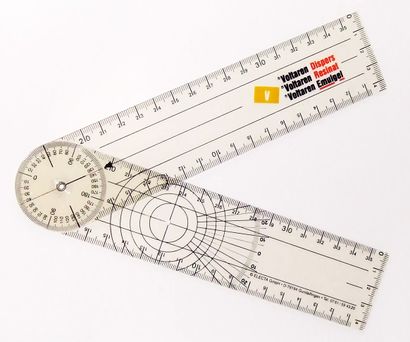Goniometry
This article is currently under review and may not be up to date. Please come back soon to see the finished work! (Template:22/ Template:SEPTEMBER/ Template:2020)
Original Editor - The Open Physio project.
Top Contributors - Innocent Abugu, Rachael Lowe, Naomi O'Reilly, Uchechukwu Chukwuemeka, Chrysolite Jyothi Kommu, Admin, Lucinda hampton, Sonal Joshi, WikiSysop, Claire Knott and Redisha Jakibanjar
Introduction[edit | edit source]
A goniometer is an instrument which measures the available range of motion at a joint. If a patient or client is suffering from decreased range of motion in a particular joint, the therapist can use a goniometer to assess what the range of motion is at the initial assessment, and then make sure the intervention is working by using the goniometer in subsequent sessions.
The term goniometry is derived from two Greek words, gonia, meaning "angle" and metron, meaning "measurement".
Goniometer have different types; the most use is the universal standard goniometer, which is either made with plastic or metal tool. It consists of a stationary arm, a movable arm and a fulcrum. Other types of goniometer use for joint range of motion measurement the telescopic-armed goniometer and some smart phone applications.
Validity and reliability[edit | edit source]
There is some question as to whether or not the use of a goniometer is a sufficiently valid and reliable instrument to determine whether an intervention has been effective[1] . Some research argues that the reliability of the measurement gotten from a goniometer depends on the type used[2][3] while some did not see any significant difference between some instruments[4][5]
Techniques for using goniometer[edit | edit source]
- It is necessary that a single notation system is used in goniometry. The neutral zero method (0 to 180 degree system) is the most widely used method.
- The same goniometer should always be used to reduce chances of instrumental error.
- The part of the body to be measured using a goniometer should be reasonably exposed and free.
- The range of motion of each joint should be measured in isolation, to avoid trick movement (simultaneous movement of another joint) and muscle insufficiency which may alter the reading.
- Both active and passive range of motion should be measured and recorded respectively.
Procedures[edit | edit source]
- Ankle (Subtalar) eversion.
- Ankle (Subtalar) inversion.
- Ankle (Talocrural) dorsiflexion.
- Ankle (Talocrural) plantarflexion.
- Elbow extension.
- Elbow flexion.
- Forearm pronation.
- Forearm supination.
- Hip abduction.
- Hip adduction.
- Hip extension.
- Hip flexion.
- Hip external rotation.
- Hip internal rotation.
- Knee extension.
- Knee flexion.
- Shoulder abduction.
- Shoulder flexion.
- Shoulder horizontal abduction.
- Shoulder internal and external rotation.
- Wrist extension.
- Wrist flexion.
- Wrist radial deviation.
- Wrist ulnar deviation.
References[edit | edit source]
- ↑ Goniometer. (2008, August 30). In Wikipedia, The Free Encyclopedia. Retrieved 11:12, September 14, 2008, from http://en.wikipedia.org/wiki/Goniometer.
- ↑ Milanese S et al. Reliability and concurrent validity of knee angle measurement: Smart phone app versus universal goniometer used by experienced and novice clinicians. Manual Therapy, 2014; 5: 1–6.
- ↑ Jones A, Sealey R, Crowe M, Gordon S. Concurrent validity and reliability of the simple goniometer iPhone app compared with the universal goniometer. Physiotherapy Theory and Practice. 2014;30 (7): 512–516.
- ↑ Mourcou Q, Fleury A, Diot B, Franco C, Vuillerme N. Mobile Phone-Based Joint Angle Measurement for Functional Assessment and Rehabilitation of Proprioception.Biomed Res Int. 2015; doi: 10.1155/2015/328142
- ↑ Ockendon M, Gilbert RE. Validation of a Novel Smartphone Accelerometer-Based Knee Goniometer. Journal of Knee Surg. 2012;25:341–346.







